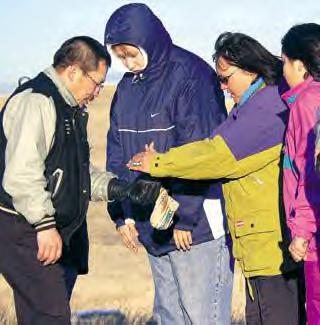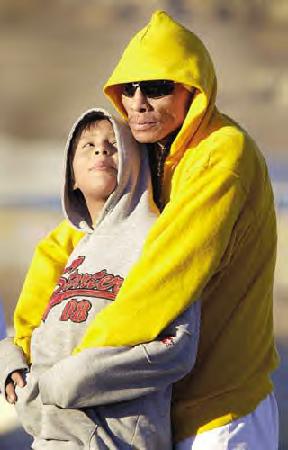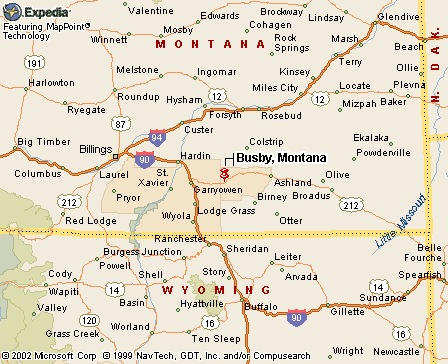|
|
Canku Ota |
|
|
(Many Paths) |
||
|
An Online Newsletter Celebrating Native America |
||
|
January 25, 2003 - Issue 79 |
||
|
|
||
|
Cheyenne Runners Retrace 400-mile Breakout Exodus |
||
|
by James Hagengruber Billings
Gazette
|
||
|
credits:Photos by
John Warner. Runners pound out the final yards of their 400-mile relay
run from Fort Robinson, Neb., to Busby on the Northern Cheyenne Reservation
Thursday. The annual Breakout Memorial Run marks the journey made 124
years ago by ancestors who broke out of captivity at the U.S. Army fort
and their historic flight to return to their homeland.
|
 BUSBY
- Moments after completing the 400-mile Breakout Memorial Run, 12-year-old
Nolan Limberhand had a hard time putting to words all the deep experiences
from the road. BUSBY
- Moments after completing the 400-mile Breakout Memorial Run, 12-year-old
Nolan Limberhand had a hard time putting to words all the deep experiences
from the road. Limberhand said he will never forget the eagles soaring above as he and about 45 other relay runners spent five days wending their way through the Black Hills of South Dakota. The visits to ancient battle sites and frigid military garrisons along the way were also seared into his memory. But as the veteran runner caught his breath at the end of the run Thursday afternoon - this was the third year he completed the journey - Limberhand said his mind kept drifting back to one truth: "You get really sore after only two days of running." The Breakout Runners retraced the Northern Cheyenne exodus in 1879 from the Fort Robinson military prison in Nebraska to their homeland near the Tongue River. Dozens were killed or died of starvation and exposure. Their corpses were collected and dissected by medical students and museum keepers. Remains of 18 of the Break Out victims were returned to Busby in 1993 and buried on a grassy hill overlooking town.
Runners carrying a sacred staff from the tribe take turns on the pavement. Caravans of vehicles follow behind. When a runner tires, another takes his or her place. Along the way, Whiteman and other leaders try to put the history and culture into perspective. This year, the runners spent time at Cheyenne Creek, a site on the Pine Ridge Reservation in South Dakota where 35 Cheyenne skulls were recently unearthed by a local farmer. This is where some Cheyenne hid after a battle, Whiteman said. When the U.S. Cavalry found the refugees, they gave them food, then blankets. The blankets were full of smallpox, and death came shortly after. Most of the runners are young boys, between ages of 7 and 12. They all must receive permission to leave school for four days - the missed assignments and exams all must be made up, Whiteman said.
"These are some of the toughest, best kids around," Whiteman said. "You can see the pride in how they run." Lance Ami, a 20-year-old Skyview High graduate, decided to join the run this year to learn about his Northern Cheyenne heritage. His body and mind were stretched during the five days. But he was amazed by the amount of energy in the group and the willingness of the runners to put aside ingrained habits. "Each of us had to cooperate to make it here," he said. "We learned not to be afraid to hold hands and pray together." Ami's parents were in the crowd near Busby waiting to greet the returning runners. Also in the crowd was Joe Walksalong Sr., a minister and former chairman of the Northern Cheyenne Tribe. Walksalong's great-grandfather, Strong Lefthand, escaped from Fort Robinson on a bitter cold night 124 years ago. Strong Lefthand was captured shortly after and hanged. "This is a heroic run," Walksalong said. "We're proud of these kids."
|
|
|
||
|
|
||
| Canku Ota is a free Newsletter celebrating Native America, its traditions and accomplishments . We do not provide subscriber or visitor names to anyone. Some articles presented in Canku Ota may contain copyright material. We have received appropriate permissions for republishing any articles. Material appearing here is distributed without profit or monetary gain to those who have expressed an interest. This is in accordance with Title 17 U.S.C. section 107. | ||
|
Canku Ota is a copyright © 2000, 2001, 2002, 2003 of Vicki Lockard and Paul Barry. |
||
 |
 |
|
|
The "Canku Ota - A Newsletter Celebrating Native America" web site and its design is the |
||
|
Copyright © 1999, 2000, 2001, 2002, 2003 of Paul C. Barry. |
||
|
All Rights Reserved. |
||
 Shortly
after the reburial, Lame Deer resident Phillip Whiteman and five others
began marking the anniversary of the escape by running around the reservation.
It was a way to remember and pray, Whiteman said. Five years ago, they
began an annual retracing of the actual route from Fort Robinson.
Shortly
after the reburial, Lame Deer resident Phillip Whiteman and five others
began marking the anniversary of the escape by running around the reservation.
It was a way to remember and pray, Whiteman said. Five years ago, they
began an annual retracing of the actual route from Fort Robinson.  At
the start of the run, the youngsters are jumpy, boisterous and out-of-touch
with the mindset of the old ways, Whiteman said. Inevitably, a transformation
takes place. The runners start listening to the stories about their
ancestors. They start getting along with each other. They stand in quiet
contemplation during prayers. They seem to savor long stretches on the
highway.
At
the start of the run, the youngsters are jumpy, boisterous and out-of-touch
with the mindset of the old ways, Whiteman said. Inevitably, a transformation
takes place. The runners start listening to the stories about their
ancestors. They start getting along with each other. They stand in quiet
contemplation during prayers. They seem to savor long stretches on the
highway. 